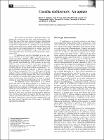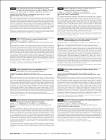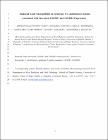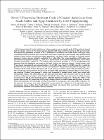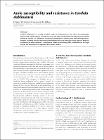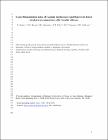Browsing School of Dental Sciences by Date of Publication
Now showing items 1-20 of 256
-
Candida dubliniensis: An update
(1999)The increased incidence of fungal infections during the last decade has been well-documented. Given that one of the most important factors contributing to this phenomenon is the increased numbers of immunocompromised ... -
An investigation into the molecular epidemiology of Candida dubliniensis
(Trinity College (Dublin, Ireland). School of Dental Science, 2002)Candida dubliniensis is a recently described Candida species primarily associated with oral candidosis in Human Immunodeficiency Virus (HlV)-infected and AIDS patients. The population structure of C. dubliniensis was ... -
Investigation into the molecular mechanisms of itraconazole resistance in Candida dubliniensis
(Trinity College (Dublin, Ireland). School of Dental Science, 2003)Candida dubliniensis is a recently identified yeast species primarily associated with oral carriage and infection in HIV-infected individuals. Previous studies have shown that only a small number of clinical isolates are ... -
COMPARATIVE GENOMICS USING CANDIDA ALBICANS DNA MICROARRAYS REVEALS ABSENCE AND DIVERGENCE OF VIRULENCE ASSOCIATED GENES IN CANDIDA DUBLINIENSIS
(2004)Candida dubliniensis is a pathogenic yeast species closely related to Candida albicans. However, it is less frequently associated with human disease and displays reduced virulence in animal models of infection. We have ... -
Reduced azole susceptibility in genotype 3 C. dubliniensis isolates associated with increased CdCDR1 and CdCDR2 expression.
(2005)Candida dubliniensis is a recently identified yeast species primarily associated with oral carriage and infection in HIV-infected individuals. The species can be divided into at least four genotypes on the basis of the ... -
Comparative genetic analysis of nosocomial methicillin-resistant Staphylococcus aureus populations in Ireland 1971-2004
(Trinity College (Dublin, Ireland). School of Dental Science, 2005)Methicillin-resistant Staphylococcus aureus (MRSA) is the most prevalent pathogen responsible for nosocomial infections worldwide and Ireland has one of the highest rates of nosocomial MRSA infections in Europe. In the ... -
Development of differential media for Candida dubliniensis and identification of a novel clade of Candida dubliniensis predominant in the Middle East
(Trinity College (Dublin, Ireland). School of Dental Science, 2005)Candida dubliniensis is a newly described Candida species originally associated with oral colonisation and candidosis in Human Immunodeficiency Virus (HlV)-infected, and acquired immunodeficiency syndrome (AIDS) patients. ... -
NOVEL 5-FLUCYTOSINE-RESISTANT CLADE OF CANDIDA DUBLINIENSIS FROM SAUDI ARABIA AND EGYPT IDENTIFIED BY CD25 FINGERPRINTING.
(2005)DNA fingerprinting of Candida dubliniensis isolates using the species-specific probe Cd25 previously showed that this species consists of two distinct groups, termed Cd25 group I and Cd25 group II. The present study ... -
An investigation into the biofilm-associated bacterial contamination of dental chair units and dental unit output water supplies and its control
(Trinity College (Dublin, Ireland). School of Dental Science, 2005)Many modern medical devices, including dental chair units (DCUs), are potential reservoirs of infection as they can harbour biofilm-associated microorganisms. This study investigated several aspects of DCUs related to ... -
AZOLE SUSCEPTIBILITY AND RESISTANCE IN CANDIDA DUBLINIENSIS
(2005)Candida dubliniensis is a recently described species of pathogenic yeast that shares many phenotypic features with Candida albicans. It is primarily associated with oral colonization and infection in HIV-infected individuals. ... -
Comparative growth analysis of Candida dubliniensis and Candida albicans in vitro and in selected infection models
(Trinity College (Dublin, Ireland). School of Dental Science, 2006)Candida dubliniensis is the species most closely related to C. albicans and is primarily associated with colonisation and oral candidiasis in Human Immunodeficiency Virus (HlV)-infected individuals and AIDS patients. Despite ... -
Comparative analysis of stress responses in C. albicans and C. dubliniensis
(Trinity College (Dublin, Ireland). School of Dental Science, 2006)Candida dubliniensis is apathogenic yeast that was first identified as a novel species in 1995. It is phylogenetically very closely related to C. albicans. However, despite the close relationship between the two species, ... -
A comparison of various methods of assessing salivary flow in normal and xerostomic subjects
(Trinity College (Dublin, Ireland). School of Dental Science, 2006)Saliva is produced by the three major paired salivary glands and minor salivary glands. Alterations in the quantity and quality of saliva have adverse effects on the oral cavity and influence patient quality of Hfe. How ... -
In vivo expression and in vitro regulation of salivary histatin 3
(Trinity College (Dublin, Ireland). School of Dental Science, 2007)Human salivary glands and the oral mucosa secrete a wide spectrum of antimicrobial agents which are believed to be essential for the protection and maintenance of a healthy oral environment. Histatins are believed to play ... -
DIFFERENTIAL REGULATION OF THE TRANSCRIPTIONAL REPRESSOR NRG1 ACCOUNTS FOR ALTERED HOST CELL INTERACTIONS IN CANDIDA ALBICANS AND CANDIDA DUBLINIENSIS
(2007)Candida dubliniensis is genetically closely related to C. albicans, but causes fewer infections in humans and exhibits reduced virulence and filamentation in animal models of infection. We investigated the role of the ... -
Studies on microdamage and remodelling around osseointegrated oral implants
(Trinity College (Dublin, Ireland). School of Dental Science, 2007) -
Lower filamentation rates of Candida dubliniensis contribute to its lower virulence in comparison with Candida albicans
(Elsevier, 2007)Candida albicans and Candida dubliniensis are very closely related yeast species. In this study, we have conducted a thorough comparison of the ability of the two species to produce hyphae and their virulence in two ... -
DIFFERENTIAL REGULATION OF THE TRANSCRIPTIONAL REPRESSOR NRG1 ACCOUNTS FOR ALTERED HOST CELL INTERACTIONS IN CANDIDA ALBICANS AND CANDIDA DUBLINIENSIS
(Blackwell Publishing, 2007-09)Candida dubliniensis is genetically closely related to C. albicans, but causes fewer infections in humans and exhibits reduced virulence and filamentation in animal models of infection. We investigated the role of the C. ... -
A susceptibility locus for lung cancer maps to nicotinic acetylcholine receptor subunit genes on 15q25.
(2008)Abstract: Lung cancer is the most common cause of cancer death worldwide, with over one million cases annually(1). To identify genetic factors that modify disease risk, we conducted a genome- wide association study by ...




